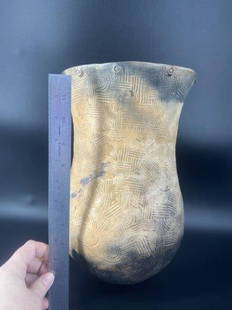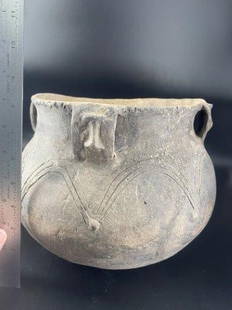
UNIDENTIFIED TLINGIT (YAKUTAT) ARTIST, Model Canoe, c. 1890-1910
Similar Sale History
View More Items in Tribal & Native American Artifacts

Related Tribal & Native American Artifacts
More Items in Tribal & Native American Artifacts
View MoreRecommended Art
View More






Item Details
Description
UNIDENTIFIED TLINGIT (YAKUTAT) ARTIST
Model Canoe, c. 1890-1910
carved alder and pigment, 4 x 18.25 x 4.5 in (10.2 x 46.4 x 11.4 cm)
unsigned.
Provenance
Private Collection, USA;
A Vancouver Collection.
This unusual canoe design, with its forward-raking bowfin, is known as a Yakutat style canoe, named for the far northern bay and Tlingit community of the same title. These were not large canoes, mostly 16 to 18 feet long, made for two or perhaps three paddlers, who went out primarily in search of seals. The function of the raked bow was perhaps two-fold: first, it served to protect the hull from thin sheet ice that would form on sheltered bays where seals were sought, by lifting and breaking the ice as the canoe moved forward; and second, it would slice the water ahead of the canoe and prevent choppy waves from slapping on the bottom of the hull, which would frighten the wary seals and cause their escape. Where the gunwales come together at each end, an outward flare like the ones on a northern style canoe served to turn off the tops of waves and keep the canoe dry within. The flat bottom on this canoe is a function of it being a display model, made to sit solidly on a shelf or mantle. The full-size canoes were softly rounded across the bottom, with the same swelling shape seen here along the waterline that paralleled the outward curves of the gunwales, established in the steaming and spreading process. The sea mammal paintings on the hull, based on the long dorsal fins, represent killer whales. The design style of these representations can be described as post-classic, varying as it does from the established formline tradition of the earlier historical period.
Steven C. Brown
References: For examples of Tlingit model canoes (including Yakutat) see the Reciprocal Research Network online database. See the section on Tlingit canoes in George Thornton Emmons (edited with additions by Frederica de Laguna), The Tlingit Indians, (Seattle: University of Washington Press / New York: American Museum of Natural History, 1991), pp. 84-98.
Model Canoe, c. 1890-1910
carved alder and pigment, 4 x 18.25 x 4.5 in (10.2 x 46.4 x 11.4 cm)
unsigned.
Provenance
Private Collection, USA;
A Vancouver Collection.
This unusual canoe design, with its forward-raking bowfin, is known as a Yakutat style canoe, named for the far northern bay and Tlingit community of the same title. These were not large canoes, mostly 16 to 18 feet long, made for two or perhaps three paddlers, who went out primarily in search of seals. The function of the raked bow was perhaps two-fold: first, it served to protect the hull from thin sheet ice that would form on sheltered bays where seals were sought, by lifting and breaking the ice as the canoe moved forward; and second, it would slice the water ahead of the canoe and prevent choppy waves from slapping on the bottom of the hull, which would frighten the wary seals and cause their escape. Where the gunwales come together at each end, an outward flare like the ones on a northern style canoe served to turn off the tops of waves and keep the canoe dry within. The flat bottom on this canoe is a function of it being a display model, made to sit solidly on a shelf or mantle. The full-size canoes were softly rounded across the bottom, with the same swelling shape seen here along the waterline that paralleled the outward curves of the gunwales, established in the steaming and spreading process. The sea mammal paintings on the hull, based on the long dorsal fins, represent killer whales. The design style of these representations can be described as post-classic, varying as it does from the established formline tradition of the earlier historical period.
Steven C. Brown
References: For examples of Tlingit model canoes (including Yakutat) see the Reciprocal Research Network online database. See the section on Tlingit canoes in George Thornton Emmons (edited with additions by Frederica de Laguna), The Tlingit Indians, (Seattle: University of Washington Press / New York: American Museum of Natural History, 1991), pp. 84-98.
Condition
The absence of condition does not imply that an item is free from defects, nor does a reference to particular defects imply the absence of any others. Our team can provide thorough and comprehensive condition reports and additional images. We welcome your enquiries at info@firstarts.ca or 647-286-5012.
NOTE
Many countries prohibit or restrict importation or exportation of property containing ivory, whale bone, sealskin, and/or products derived from other endangered or protected species, and require special licenses or permits in order to import or export such property. It is the responsibility of the buyer to ensure that the item is properly and lawfully exported / imported.
NOTE
Many countries prohibit or restrict importation or exportation of property containing ivory, whale bone, sealskin, and/or products derived from other endangered or protected species, and require special licenses or permits in order to import or export such property. It is the responsibility of the buyer to ensure that the item is properly and lawfully exported / imported.
Buyer's Premium
- 23%
UNIDENTIFIED TLINGIT (YAKUTAT) ARTIST, Model Canoe, c. 1890-1910
Estimate CA$3,000 - CA$5,000
13 bidders are watching this item.
Shipping & Pickup Options
Item located in Toronto, Ontario, caSee Policy for Shipping
Local Pickup Available
Payment

TOP


































![UNIDENTIFIED TLINGIT ARTIST, Feast Tray, c. 1850: UNIDENTIFIED TLINGIT ARTIST Feast Tray, c. 1850 wood, 34.5 x 9 x 4.5 in (87.6 x 22.9 x 11.4 cm) unsigned; inscribed indistinctly in graphite in an unknown hand, "WSS[?] ?" Provenance Private Collectio](https://p1.liveauctioneers.com/7222/249743/129652566_1_x.jpg?height=310&quality=70&version=1653677113)















































